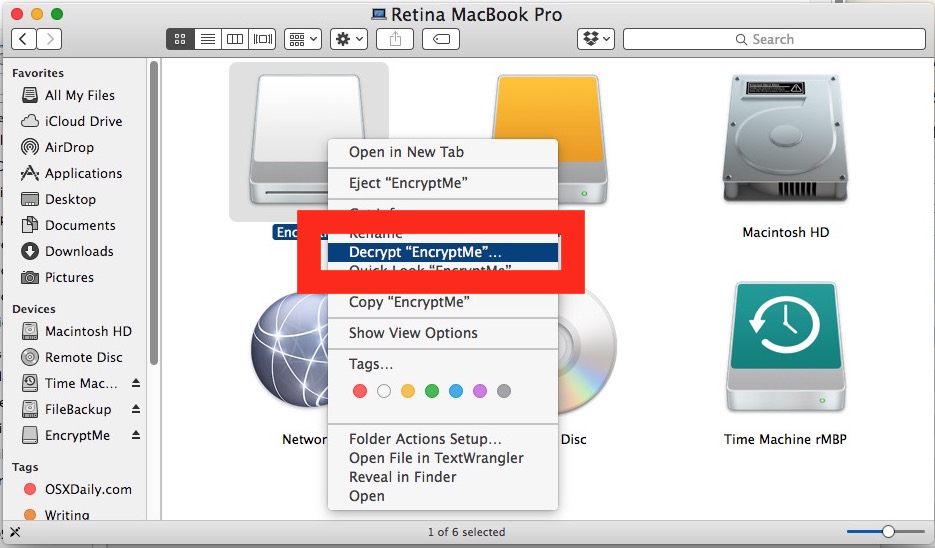- Learn how to add a password to your hard drives to protect your data. Also, if you’re experiencing the “Media Kit Reports not enough space on device for requ.
- Insert your drive and transfer any files on it somewhere safe. Open Finder and find Disk Utility. Choose your device from the list on the left-hand side. Go to the Erase tab. In the Format box choose Mac OS Extended (Journaled, Encrypted). Here you can choose a name for your drive. A window will open asking you to enter a.
Use the following steps in OS X Mountain Lion (10.8) and up to encrypt (and decrypt) external disks, including flash drives, from the Finder.
- Open a new Finder window and select the external drive you would like to encrypt from the panel on the left, under Devices.
- Right-click (or two-finger click, or control-click) on this disk in order to bring up a contextual menu, and then select Encrypt 'External Drive Name'...
- When prompted to create an encryption password, use a strong password and enter it twice, along with a password hint, and click Encrypt Disk.
Result: The external disk will begin to encrypt, however, there is no progress bar to show you the process of the encryption, which could take as few as a couple of minutes up to several hours for large disks. The best way to tell that the encryption is taking place is to watch the activity indicator light for your disk, if it has one, and if it is blinking do not disconnect it as the encryption process is likely still in progress. - Once encrypted, when you next plug your external drive in, you will be prompted to enter the password you created earlier and click Unlock in order to unlock the disk. If you would like to skip this step when accessing this disk on your primary Mac, you can choose to select the checkbox to Remember this password in my keychain.
GUID Error Message Resolution
If you at step 3 above you get an error message saying 'A GUID Partitioning Table (GPT) partitioning scheme is required.', please go to this Knowledge Base article for a resolution.
Disk Utility User Guide
When you format an internal or external storage device, you can encrypt and protect it with a password. If you encrypt an internal device, you must enter a password to access the device and its information. If you encrypt an external device, you must enter the password when you connect the device to your computer.
Also, if you choose to encrypt an external disk, it will be necessary to enter the password once said device is connected to Mac machine. Now, having clarified the above, we proceed to mention each and every one of the steps indicated to achieve encryption of an internal or external hard drive in MacOS, correctly, quickly and easily.
If you encrypt an external storage device, you can’t connect it to an AirPort base station for Time Machine backups.
Encrypt External Drive Macos
WARNING: To encrypt and protect the device with a password using Disk Utility, you must erase the device first. If the device contains files you want to save, be sure to copy them to another storage device or volume.
If the device contains any files you want to save, copy them to another storage device or volume.
In the Disk Utility app on your Mac, choose View > Show All Devices.
If Disk Utility isn’t open, click the Launchpad icon in the Dock, type Disk Utility in the Search field, then click the Disk Utility icon .
In the sidebar, select the storage device you want to encrypt.
Click the Erase button in the toolbar.
Enter a name for the volume.
Click the Scheme pop-up menu, then choose GUID Partition Map.
Click the Format pop-up menu, then choose an encrypted file system format.
Enter and verify a password, then click Choose.
To change the password later, select the volume in the sidebar, then choose File > Change Password.
(Optional) If available, click Security Options, use the slider to choose how many times to write over the erased data, then click OK.
Secure erase options are available only for some types of storage devices. If the Security Options button is not available, you can’t use Disk Utility to perform a secure erase on the storage device.
Click Erase, then click Done.
You can encrypt your data without erasing it by turning on FileVault in the Security & Privacy pane of System Preferences (see Encrypt Mac data with FileVault).

Encrypt External Hard Drive Mac Os

Encrypt External Drive Mac
You can also encrypt a disk and protect it with a password without erasing it. See Encrypt disks or memory cards to protect your Mac information.
